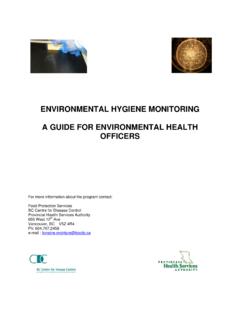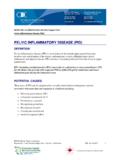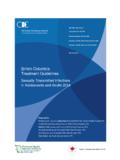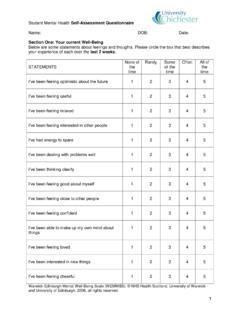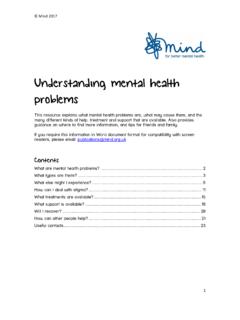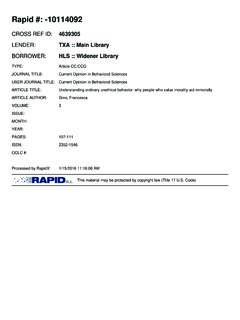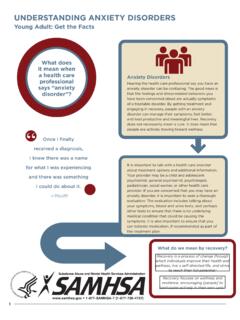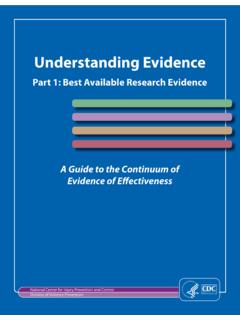Transcription of HARM REDUCTION TRAINING MANUAL
1 harm REDUCTION TRAINING MANUAL . A MANUAL for Frontline Staff Involved with harm REDUCTION Strategies and Services January 2011. i) Letter to Reader This MANUAL has been provided as a tool to assist you in your service to help reduce the harms associated with drug use to individuals, families and within your community. We encourage using and sharing these tools and information provided to promote growth in the knowledge and understanding of harm REDUCTION within your communities. harm REDUCTION continuously changes and we encourage you to follow the web links provided to remain up to date on the changes, information, policies, and forms. ii) Current/ updated information The latest: BC harm REDUCTION Strategies and Services Policy and Guidelines harm REDUCTION Program: Supply Requisition Form Can be found at: Health link BC Health files can be accessed at: Note about footers and updates: Footer dates will only be changed on those pages that have been amended; all other footers will remain unchanged.
2 Pages to be removed and replaced along with date of modification will be recorded on the last page of the MANUAL . Updated January 2011. TABLE OF CONTENTS. INTRODUCTION ..4. 1. harm REDUCTION ..5. DEFINITIONS OF harm GUIDING PRINCIPLES OF harm REDUCTION ..5. harm REDUCTION IN CANADA AND INTERNATIONALLY ..4. 2. INFECTIONS ..7. HIV/AIDS ..8. HEPATITIS ..8. SEXUALLY TRANSMITTED INFECTIONS ..9. Chlamydia ..9. Genital Herpes ..9. Gonorrhea ..9. Human Papillomavirus (HPV) ..10. 3. DRUG 4. SAFER SUBSTANCE 5. MENTAL HEALTH ..18. 6. WORKING WITH PERSONAL VALUES, ATTITUDES AND MISCONCEPTIONS ..19. INDIVIDUAL ENGAGEMENT STRATEGIES ..19. RESPONDING TO A HISTORY OF ABUSE ..20. FAMILIES, INDIVIDUAL AND ABORIGINAL COMMUNITIES ..22. REFERRING CLIENTS TO OTHER SERVICES.
3 22. ADVOCATING FOR YOUTH ..23. LESBIAN, GAY, TRANSGENDERED, BISEXUAL, QUEER (LGTBQ) ..23. 7. APPENDICES ..23. 1. harm REDUCTION . harm REDUCTION : History of harm REDUCTION in British Columbia 1A: harm REDUCTION Definitions, Reducing harm : Treatment and Beyond. Four Pillars Drug Strategy 1B: harm REDUCTION : A British Columbia Community Guide 1C: harm REDUCTION health files #102a #102b 1D: BC harm REDUCTION Strategies and Services Policy and Guidelines 1E: BC harm REDUCTION Strategy and Services (HRSS) Committee Primary, Secondary and One-off Distribution Site Policy 1F: Strategies harm REDUCTION Strategies and Services newsletters 2. INFECTIONS (BC health files #). 2A: HIV/AIDS #08m 2B: Hepatitis A vaccine #33; hepatitis B vaccine #25a; hepatitis C virus #40a; Living well with hepatitis C infection #40b 2C: Chlamydia #08l 2D: Genital Herpes #08d Updated January 2011.
4 2E: Gonorrhea #08a 2F: Human Papillomavirus (HPV) #101a 2G: Syphilis #08e 3. DRUG EFFECTS. 3A: Street Definitions 4. SAFER SUBSTANCE USE. 4A: harm REDUCTION Program: Supply Requisition Form 4B: harm REDUCTION Supply Ordering at the BCCDC. 4C: Rationale for crack pipe mouthpiece distribution Questions and Answers: Female condoms Sterile water Cookers and Injection Drug Use Stericup cooker: Cooker instructions Acidifier (Ascorbic acid) and Injection Drug Use Crack pipe push sticks Crack pipe mouthpieces 4D: More than just needles: an evidence informed approach to enhancing harm REDUCTION supply distribution in British Columbia 4E: Best Practices for British Columbia harm REDUCTION Supply Distribution Program (September 2008). 4F: harm REDUCTION Learning Series Pamphlets 6.
5 WORKING WITH INDIVIDUALS. ABORIGINAL. 6A: Walk With Me: Pathways to Health; harm REDUCTION Service Delivery Model 6B: Community Readiness: A Handbook for Successful Change: Please download from website LESBIAN, GAY, TRANSGENDER, BISEXUAL AND QUEER. 6C: List of Suggested Readings 6D: Glossary of Terms 7. ACTIVITY AND ENGAGEMENT EXCERCISES. 7A: Client engagement / role play activity 7B: 5-min elevator pitch 7C: Peer engagement: benefits and challenges activity 8. RESOURCES. Updated January 2011. Introduction The purpose of this MANUAL is to build on the knowledge, skills, and attitudes necessary to maximize the distribution of products to reduce harms associated with substance use; and to engage, educate, and advocate for individuals.
6 The MANUAL outlines and encourages the use of best practice to colleagues and peers within their specific agencies and organizations. It provides a reference to what support and treatment resources are available to which they can refer individuals. Specifically frontline staff will be able to use the MANUAL as a guide and reference tool for: Individual engagement Encourage and support needle collection and return (at the individual and community levels). Inform individuals about reducing risks of blood borne pathogen transmission, and safer drug using and sexual practices Engage with individuals to provide effective education regarding harm REDUCTION practices associated with routes of use, substances used, and social use practices.
7 Respond to individuals who report a history of past or recent trauma, abuse or violence Refer individuals ( social services, housing, addiction and mental health treatment). Advocate for individuals Respond to community pressures and concerns. Updated February 2010 4. 1. harm REDUCTION At the end of this section, you will be able to explain: Definition for harm REDUCTION Everyday examples of harm reductions interventions. The guiding principles of harm REDUCTION The history of harm REDUCTION within Vancouver and globally It is important to acknowledge that harm REDUCTION is not a new concept. harm REDUCTION principles have been applied for many decades in many areas outside the field of addiction. Day to day strategies such as using a seatbelt while driving a car, wearing sunglasses while outside, or using hand rails when walking down stairs are all examples of an intervention to help reduce harm .
8 What are some examples of harm REDUCTION strategies that you use in your everyday life? Definitions of harm REDUCTION harm REDUCTION has a variety of meanings to different people, which has made developing one general definition very difficult. Regardless of the definition, harm REDUCTION is a philosophy, approach, and a set of principles that combined help achieve certain social and political goals. As per the BC harm REDUCTION Strategies and Services Policy and Guidelines: harm REDUCTION involves taking action through policy and programming to reduce the harmful effects of behaviour. It involves a range of non-judgmental approaches and strategies aimed at providing and enhancing the knowledge, skills resources and supports for individuals, their families and communities to make informed decisions to be safer and healthier.
9 For further definitions of harm REDUCTION and Reducing Harms: Treatment and Beyond see Appendix 1A. Guiding Principles of harm REDUCTION The principles of harm REDUCTION as outlined in the harm REDUCTION : British Columbia Community Guide (2005) (Appendix 1B) are summarized below. PRAGMATISM - harm REDUCTION recognizes that drug use is a complex and multi-faceted phenomenon that encompasses a continuum of behaviors from abstinence to chronic dependence and produces varying degrees of social harm . harm REDUCTION accepts that the non- medical use of psychoactive or mood altering substances is a universal phenomenon. It acknowledges that, while carrying risks, drug use also provides the user and society with benefits that must be taken into account.
10 HUMAN RIGHTS - harm REDUCTION respects the basic human dignity and rights of people who use drugs. It accepts the drug user's decision to use drug and no judgment is made either to condemn or support the use of drugs. harm REDUCTION acknowledges an individual drug user's right to self-determination and supports informed decision making in the context of active drug use. Emphasis is placed on personal choice, responsibility and management. Updated February 2010 5. FOCUS ON HARMS - The fact or extent of an individual's drug use is secondary to the harms from drug use. The priority is to decrease the negative consequences of drug use to the user and others, rather than decrease drug use itself. While harm REDUCTION emphasizes a change to safer practices and patterns of drug use, it recognizes the need for strategies at all stages along the continuum of drug use.


